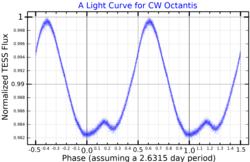CW Octantis
| Observation data EpochJ2000.0EquinoxJ2000.0(ICRS) | |
|---|---|
| Constellation | Octans |
| Right ascension | 17h00m58.51777s[2] |
| Declination | −86° 21′ 51.4707″[2] |
| Apparent magnitude(V) | 6.03±0.01[3] |
| Characteristics | |
| Evolutionary stage | subgiant[4] |
| Spectral type | A3 IV[5] |
| U−Bcolor index | +0.02[6] |
| B−Vcolor index | +0.05[6] |
| Variable type | α2CVn[7] |
| Astrometry | |
| Radial velocity(Rv) | 7.1±0.5[8]km/s |
| Proper motion(μ) | RA:+8.413mas/yr[2] Dec.:−0.032mas/yr[2] |
| Parallax(π) | 5.1828 ± 0.0486mas[2] |
| Distance | 629 ± 6ly (193 ± 2pc) |
| Absolute magnitude(MV) | −0.36[9] |
| Details | |
| Mass | 2.98±0.05[4]M☉ |
| Radius | 4.64[10]R☉ |
| Luminosity | 111[11]L☉ |
| Surface gravity(logg) | 3.45±0.07[12]cgs |
| Temperature | 8,791[13]K |
| Metallicity[Fe/H] | +0.6[14]dex |
| Rotation | ≈2.8days[13] |
| Rotational velocity(vsini) | 92±6[13]km/s |
| Age | 188±4[4]Myr |
| Other designations | |
| Database references | |
| SIMBAD | data |
CW Octantis,also known asHD 148542,is a solitary, white huedvariable starlocated in the southerncircumpolar constellationOctans.It has anapparent magnitudeof 6.03, allowing it to be faintly visible to thenaked eye.Parallaxmeasurements fromGaia DR3place the object at a distance of 629light years.It appears to be receding from theSolar Systemwith a heliocentricradial velocityof7.1km/s.
CW Octantis has astellar classificationof A3 IV, indicating that it is an evolvedA-type starheading towards thered giant branch.Zorec and Royer (2012) model it as a dwarf star that has just reached the end of itsmain sequencelifetime.[4]It has 2.98 times themass of the Sun[4]and 4.6 times itsradius.[10]It radiates 111 times theluminosity of the Sun[11]from itsphotosphereat aneffective temperatureof8,791K.[13]CW Octantis is estimated to be 188million yearsold.[4]
This object is classified as aAlpha2Canum Venaticorum variable.[7]Most stars of this class have chemical peculiarities in theirspectra,but CW Octantis seems to be ordinary. Renson and Manfroid (2009) consider its peculiarity status to be doubtful.[17]Nevertheless, CW Octantis fluctuates between 6.05 and 6.07 in theHipparcos passbandwithin 2.63days.[18]It takes 2.8 days to complete a full a rotation, which corresponds to aprojected rotational velocityof92km/s.[13]
References
[edit]- ^"MAST: Barbara A. Mikulski Archive for Space Telescopes".Space Telescope Science Institute.Retrieved1 October2022.
- ^abcdVallenari, A.; et al. (Gaia collaboration) (2023)."GaiaData Release 3. Summary of the content and survey properties ".Astronomy and Astrophysics.674:A1.arXiv:2208.00211.Bibcode:2023A&A...674A...1G.doi:10.1051/0004-6361/202243940.S2CID244398875. Gaia DR3 record for this sourceatVizieR.
- ^Høg, E.; Fabricius, C.; Makarov, V. V.; Urban, S.; Corbin, T.; Wycoff, G.; Bastian, U.; Schwekendiek, P.; Wicenec, A. (March 2000). "The Tycho-2 catalogue of the 2.5 million brightest stars".Astronomy and Astrophysics.355:L27–L30.Bibcode:2000A&A...355L..27H.ISSN0004-6361.
- ^abcdefZorec, J.; Royer, F. (January 2012)."Rotational velocities of A-type stars. IV. Evolution of rotational velocities".Astronomy and Astrophysics.537:A120.arXiv:1201.2052.Bibcode:2012A&A...537A.120Z.doi:10.1051/0004-6361/201117691.ISSN0004-6361.S2CID55586789.
- ^de Vaucouleurs, A. (1 August 1957)."Spectral Types and Luminosities of B, A and F Southern Stars".Monthly Notices of the Royal Astronomical Society.117(4): 449–462.Bibcode:1957MNRAS.117..449D.doi:10.1093/mnras/117.4.449.eISSN1365-2966.ISSN0035-8711.
- ^abJohnson, H. L.; Mitchell, R. I.; Iriarte, B.; Wisniewski, W. Z. (1966). "UBVRIJKL Photometry of the Bright Stars".Communications of the Lunar and Planetary Laboratory.4:99–110.Bibcode:1966CoLPL...4...99J.
- ^abSamus’, N. N.; Goranskii, V. P.; Durlevich, O. V.; Zharova, A. V.; Kazarovets, E. V.; Kireeva, N. N.; Pastukhova, E. N.; Williams, D. B.; Hazen, M. L. (July 2003). "An electronic version of the second volume of the General Catalogue of Variable Stars with improved coordinates".Astronomy Letters.29(7): 468–479.Bibcode:2003AstL...29..468S.doi:10.1134/1.1589864.eISSN1562-6873.ISSN1063-7737.S2CID16299532.
- ^Gontcharov, G. A. (November 2006). "Pulkovo Compilation of Radial Velocities for 35,495 Hipparcos stars in a common system".Astronomy Letters.32(11): 759–771.arXiv:1606.08053.Bibcode:2006AstL...32..759G.doi:10.1134/S1063773706110065.eISSN1562-6873.ISSN1063-7737.S2CID119231169.
- ^Anderson, E.; Francis, Ch. (May 2012). "XHIP: An extended hipparcos compilation".Astronomy Letters.38(5): 331–346.arXiv:1108.4971.Bibcode:2012AstL...38..331A.doi:10.1134/S1063773712050015.eISSN1562-6873.ISSN1063-7737.S2CID119257644.
- ^abKervella, Pierre; Arenou, Frédéric; Thévenin, Frédéric (2022)."Stellar and substellar companions fromGaiaEDR3 ".Astronomy & Astrophysics.657:A7.arXiv:2109.10912.Bibcode:2022A&A...657A...7K.doi:10.1051/0004-6361/202142146.eISSN1432-0746.ISSN0004-6361.
- ^abMcDonald, I.; Zijlstra, A. A.; Boyer, M. L. (21 November 2012)."Fundamental parameters and infrared excesses of Hipparcos stars: Parameters and IR excesses from Hipparcos".Monthly Notices of the Royal Astronomical Society.427(1): 343–357.arXiv:1208.2037.Bibcode:2012MNRAS.427..343M.doi:10.1111/j.1365-2966.2012.21873.x.ISSN0035-8711.
- ^Stassun, Keivan G.; et al. (9 September 2019)."The RevisedTESSInput Catalog and Candidate Target List ".The Astronomical Journal.158(4): 138.arXiv:1905.10694.Bibcode:2019AJ....158..138S.doi:10.3847/1538-3881/ab3467.eISSN1538-3881.
- ^abcdeReiners, A.; Royer, F. (February 2004)."First signatures of strong differential rotation in A-type stars".Astronomy & Astrophysics.415(1): 325–329.arXiv:astro-ph/0311341.Bibcode:2004A&A...415..325R.doi:10.1051/0004-6361:20034175.eISSN1432-0746.ISSN0004-6361.
- ^Rainer, M.; Poretti, E.; Mistò, A.; Panzera, M. R.; Molinaro, M.; Cepparo, F.; Roth, M.; Michel, E.; Monteiro, M. J. P. F. G. (5 December 2016)."The SpaceInn-SISMA Database: Characterization of a Large Sample of Variable and Active Stars by Means of Harps Spectra".The Astronomical Journal.152(6): 207.arXiv:1611.02715.Bibcode:2016AJ....152..207R.doi:10.3847/0004-6256/152/6/207.eISSN1538-3881.
- ^Gould, Benjamin Apthorp (1878). "Uranometria Argentina: brillantez y posicion de las estrellas fijas, hasta la septima magnitud, comprendidas dentro de cien grados del polo austral: con atlas".Resultados del Observatorio Nacional Argentino.1.Bibcode:1879RNAO....1.....G.
- ^"CW Oct".SIMBAD.Centre de données astronomiques de Strasbourg.RetrievedOctober 1,2022.
- ^Renson, P.; Manfroid, J. (19 March 2009)."Catalogue of Ap, HgMn and Am stars".Astronomy & Astrophysics.498(3): 961–966.Bibcode:2009A&A...498..961R.doi:10.1051/0004-6361/200810788.eISSN1432-0746.ISSN0004-6361.
- ^Watson, C. L.; Henden, A. A.; Price, A. (May 2006). "The International Variable Star Index (VSX)".Society for Astronomical Sciences Annual Symposium.25:47.Bibcode:2006SASS...25...47W.

